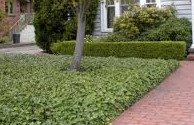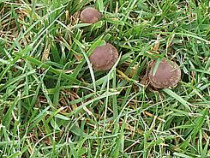The grass in a yard many times is a primary component of any landscape design.
Not only is it pleasing to look at, it also serves a multitude of purposes ranging from preventing soil erosion, tying together other plantings, and also keeping dirt from being tracked into the home.
Unfortunately, there are many mistakes homeowners make in regards to the lawn and landscape design.
Lawn Considerations and Ground Cover
Lawn areas that are too small are difficult to maintain in some instances; their small size can hinder regular trimming, as well as be unable to thrive well. Be sure to allow proper room for your ground cover when placing shrubs and trees.
Another common mistake is ninety degree corners, also known as straight corners. These are difficult to mow and water effectively (okay ninety degree corners are not a “mistake” but let’s face it, rounded corners work much better and are more appealing to the eye).
Curved areas of ground cover are not only easier to mow, but also easier to adequately water as well. Bordering these areas with pathway bricks or landscape stones also assist in the ease of maintenance and act as a visual aid as well.

Grass Types That Work Well in Houston
Choosing the proper type of grass is also a key in ensuring a lush healthy lawn.
Often many people think “grass is grass” when there are many species for different regions. Some of the best choices for our area are:
- St. Augustine
- Floratam
New varieties of St Augustine are also being introduced that appear to fare very well in our area. For a more complete list, see my article here for Houston Grass types that work well.
If you have a particularly shady ares of your yard, instead of attempting to force grass to grow there, opt for shady ground covers in lieu of grass.

Examples of ground covers are:
- ivy (pictured)
- liriope
- monkey grass
- jasmine
Click the link above for a more complete list.
Pay attention to other areas of the yard as well that may not be conducive to grass thriving; such as, heavy traffic paths, steep slopes, poor drainage and drier areas.
Caring for Your Grass
As with any other living thing, grass needs care.
Consistent watering, fertilization, and mowing are all part of the upkeep. Attempting to withhold any of these necessary maintenance tasks will result in a straggly lawn that be prone to disease and pest invasion.
Too much watering, for example, can cause dangerous mushrooms to grow.

The key points to remember in a lush green lawn are simple:
- water
- ample sunlight
- good soil beneath- in some cases, it’s necessary to add 4″ of top soil under the grass to ensure proper root development
- penetration
If your soil is heavy clay or sand based subsoil, it may be necessary to add 2″ of humus to it.
The pH of the soil should also be measured. A simple kit from a garden center can tell you what pH your soil is.
Ideally, the pH for grass should be 5.5 to 6.5. Elements are readily available to help ensure your soil will support a lush, healthy lawn.

